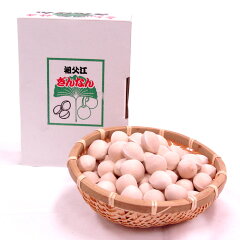Japanese page
Nutrient content per 100 g
Delicious season
Ginko nuts
| ① | ② | ③ | ④ | ⑤ | ⑥ | ⑦ | ⑧ | ⑨ | ⑩ | ⑪ | ⑫ |
|---|
* Display the yearly calendar with each number
Commentary on vegetables
- A tree that has long been said to be a living fossil
- Eat endosperm seeds in berries that become ginkgo trees
- Gingko has a male tree and a female tree.
- Autumn taste with unique flavor and texture
- Rich in carotene, carbohydrates, vitamin C, vitamin B, etc.
- Eating large amounts may cause food poisoning
- It is better to limit the number to children and not give to children under 5 years old
- Ginkgo is alkaline
Ginkgo Pretreatment method
- Soak gingko in water (2-3 days)
- Peel the skin away from direct contact (use rubber gloves, etc.)
- Dry in the sun
- Crack in the shell and dry in a frying pan
- Remove the contents from the shell, boil the salt and remove the skin
- Can be stored frozen in this state
Preservation method
- Put it in a paper bag and store it in the vegetable room
- Remove shell, boil salt, remove skin and store frozen
recipe
- Grilled food
- Boiled food
- salad
- Fried food
Food composition table
Per 100g edible portion
Ginko nuts(boiled)
| Waste rate | 0% |
| Energy | 174㎉ |
| moisture | 56.9g |
| Protein | 4.6g |
| Lipid | 1.5g |
| Carbohydrate | 35.8g |
| Sodium | 1㎎ |
| Potassium | 580㎎ |
| Calcium | 5㎎ |
| Magnesium | 45㎎ |
| Rin | 96㎎ |
| iron | 1.2㎎ |
| Zinc | 0.4㎎ |
| Copper | 0.23㎎ |
| Manganese | 0.25㎎ |
| Lodine | – |
| Selenium | 1㎍ |
| Chromium | 5㎍ |
| Molybdenum | – |
| Vitamin A(Retinol) | – |
| Vitamin A(β-carotene) | – |
| Vitamin D | – |
| Vitamin E(Tocopherol α) | 1.6㎎ |
| Vitamin K | 3㎍ |
| Vitamin B1 | 0.26㎎ |
| Vitamin B2 | 0.07㎎ |
| Niacin | 1.0㎎ |
| Vitamin B6 | 0.02㎎ |
| Vitamin B12 | – |
| Folic acid | 38㎍ |
| Pantothenic acid | 1.02㎎ |
| Biotin | 2.8㎍ |
| Vitamin C | 23㎎ |
| Dietary fiber(aggregate amount) | 2.4g |
Quoted from the Japanese food standard composition table 2015 edition

